合并多个绘图
以下示例说明了如何使用 hold 函数合并同一坐标区中的绘图,以及如何使用 tiledlayout 函数在图窗中创建多个坐标区。
在同一坐标区中合并绘图
默认情况下,新图将清除现有图,并重置标题等坐标区属性。但是,您可以使用 hold on 命令在同一坐标区中合并多个图。例如,绘制两条直线和一个散点图,然后将保留状态重置为 off。
x = linspace(0,10,50); y1 = sin(x); plot(x,y1) title('Combine Plots') hold on y2 = sin(x/2); plot(x,y2) y3 = 2*sin(x); scatter(x,y3) hold off
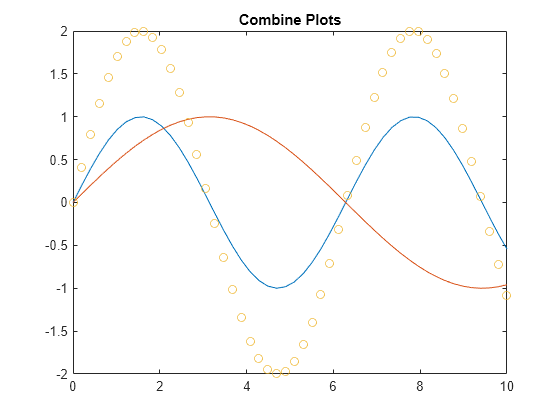
启用保留状态后,新图不会清除现有图,也不会重置标题或轴标签等坐标区属性。新图将根据坐标区的 ColorOrder 和 LineStyleOrder 属性循环使用颜色和线型。坐标区范围和刻度值可能会进行调整以适应新数据。
在图窗中显示多个坐标区
您可以使用 tiledlayout 函数在单个图窗中显示多个坐标区。此函数将创建一个分块图布局,该布局将图窗分为一系列不可见的图块网格。每个图块可以包含一个用于显示绘图的坐标区。创建布局后,调用 nexttile 函数将坐标区对象放置到布局中。然后调用绘图函数在该坐标区中绘图。例如,在一个 2×1 布局中创建两个绘图。为每个绘图添加标题。
x = linspace(0,10,50); y1 = sin(x); y2 = rand(50,1); tiledlayout(2,1) % Top plot nexttile plot(x,y1) title('Plot 1') % Bottom plot nexttile scatter(x,y2) title('Plot 2')
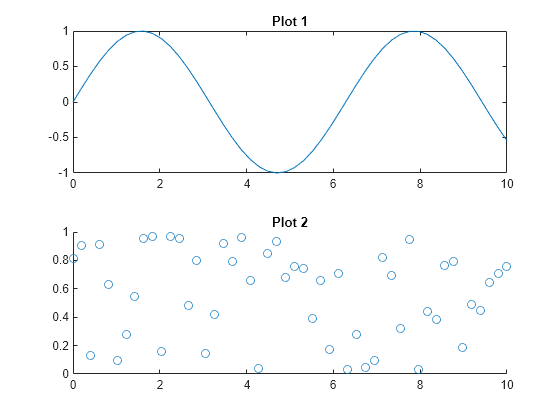
创建跨多行或多列的绘图
要创建跨多行或多列的绘图,请在调用 nexttile 时指定 span 参量。例如,创建一个 2×2 布局。绘制前两个图块。然后创建一个跨一行两列的图。
x = linspace(0,10,50); y1 = sin(x); y2 = rand(50,1); % Top two plots tiledlayout(2,2) nexttile plot(x,y1) nexttile scatter(x,y2) % Plot that spans nexttile([1 2]) y2 = rand(50,1); plot(x,y2)

修改坐标区外观
通过在每个坐标区对象上设置属性来修改坐标区外观。您可以通过带输出参量调用 nexttile 函数来获取坐标区对象。您也可以将坐标区对象指定为图形函数的第一个输入参量,以确保该函数作用于正确的坐标区。
例如,创建两个绘图,并将坐标区对象赋给变量 ax1 和 ax2。更改第一个绘图的坐标区字体大小和 x 轴颜色。为第二个绘图添加网格线。
x = linspace(0,10,50); y1 = sin(x); y2 = rand(50,1); tiledlayout(2,1) % Top plot ax1 = nexttile; plot(ax1,x,y1) title(ax1,'Plot 1') ax1.FontSize = 14; ax1.XColor = 'red'; % Bottom plot ax2 = nexttile; scatter(ax2,x,y2) title(ax2,'Plot 2') grid(ax2,'on')
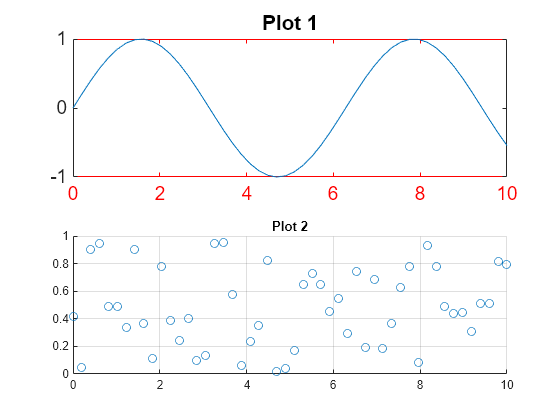
控制图块周围的间距
您可以通过指定 Padding 和 TileSpacing 属性来控制布局中图块周围的间距。例如,在一个 2×2 布局中显示四个绘图。
x = linspace(0,30);
y1 = sin(x);
y2 = sin(x/2);
y3 = sin(x/3);
y4 = sin(x/4);
% Create plots
t = tiledlayout(2,2);
nexttile
plot(x,y1)
nexttile
plot(x,y2)
nexttile
plot(x,y3)
nexttile
plot(x,y4)
通过将 Padding 和 TileSpacing 属性设置为 'compact',减小布局四周和每个图块周围的间距。
t.Padding = 'compact'; t.TileSpacing = 'compact';

显示共享标题和轴标签
您可以在布局中显示共享标题和共享轴标签。创建一个 2×1 布局 t。然后显示一个线图和一个针状图。通过调用 linkaxes 函数来同步 x 轴范围。
x1 = linspace(0,20,100); y1 = sin(x1); x2 = 3:17; y2 = rand(1,15); % Create plots. t = tiledlayout(2,1); ax1 = nexttile; plot(ax1,x1,y1) ax2 = nexttile; stem(ax2,x2,y2) % Link the axes linkaxes([ax1,ax2],'x');
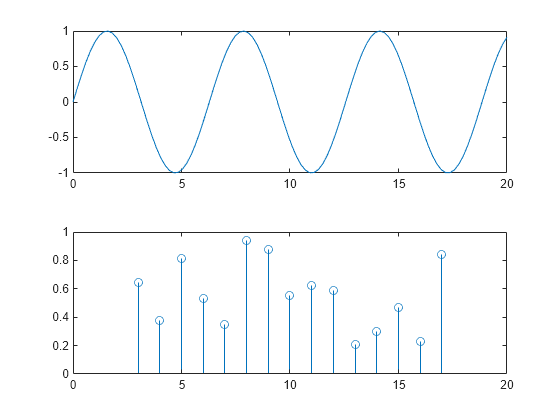
通过将 t 传递给 title、xlabel 和 ylabel 函数,添加共享标题和共享轴标签。通过从顶部图中删除 x 轴刻度标签,并将 t 的 TileSpacing 属性设置为 'compact',让图彼此更靠近。
% Add shared title and axis labels title(t,'My Title') xlabel(t,'x-values') ylabel(t,'y-values') % Move plots closer together xticklabels(ax1,{}) t.TileSpacing = 'compact';
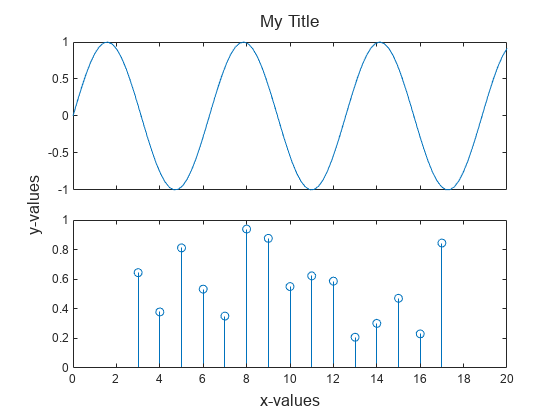
另请参阅
函数
tiledlayout|nexttile|title|hold